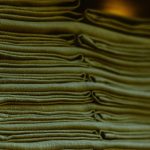Are you tired of your linen fabrics wearing out too quickly? Look no further! In this article, we’ll share with you some proven linen fabric care tips for longevity.
With our washing techniques, drying methods, stain removal tips, ironing tricks, storage recommendations, dealing with wrinkles, and professional cleaning advice, you’ll be able to keep your linen fabrics looking fresh and lasting longer.
So, let’s dive in and start taking better care of your beloved linens!
Table of Contents
Washing Techniques
To properly care for your linen fabric and ensure its longevity, use the appropriate washing techniques.
When it comes to washing your linen, you have two main options: hand washing or using the delicate cycle on your washing machine.
Hand washing is a gentle and effective method that allows you to have more control over the process. Start by filling a basin with lukewarm water and add a mild detergent specifically formulated for delicate fabrics. Gently agitate the water to create suds, then submerge your linen fabric and swish it around for a few minutes. Avoid wringing or twisting the fabric, as this can cause damage. Instead, carefully lift the fabric out of the water and gently squeeze out the excess moisture. Rinse the linen thoroughly with clean water until all the soap is gone.
If you prefer using a washing machine, opt for the delicate cycle with cold water and a mild detergent. Place the linen fabric in a mesh laundry bag to prevent tangling or snagging. Once the cycle is complete, remove the fabric immediately and lay it flat to dry.
Following these washing techniques will help keep your linen fabric looking fresh and vibrant for years to come.
Drying Methods
When it comes to drying your linen fabric, there are a few key points to keep in mind.
First, air drying is the best method as it helps to preserve the fabric’s quality and prevent shrinkage.
Second, it’s important to avoid high heat, as this can damage the fibers.
Lastly, proper hanging techniques will ensure that your linen dries evenly and without creases.
Air Drying Benefits
You should regularly air dry your linen fabric to ensure its longevity and maintain its quality. Air drying offers several benefits over other drying methods, such as preventing shrinkage and preserving the natural texture of the fabric. Fabric softener is commonly used during the washing process to make linen sheets soft and comfortable. However, it is important to note that using fabric softener can leave a residue on the fabric, reducing its absorbency and breathability. Therefore, it is best to avoid using fabric softener when washing linen sheets. When it comes to folding linen sheets, there are some best practices to follow. Folding them neatly and properly helps to prevent wrinkles and maintain their crisp appearance. Here are some guidelines for folding linen sheets:
| Best Practices for Folding Linen Sheets |
|---|
| Fold immediately after drying |
| Smooth out any wrinkles or creases |
| Fold in thirds for easier storage |
| Store in a cool, dry place |
| Avoid folding linen sheets multiple times |
Avoid High Heat
One important way to care for your linen fabric and ensure its longevity is by avoiding high heat in the drying process.
When it comes to drying your linen, you have two options: air drying or tumble drying. While tumble drying may be convenient, it can be harsh on your linen fabric due to the high heat involved. High heat can cause shrinkage, weakening the fibers and reducing the overall lifespan of your linen.
On the other hand, air drying is a gentle and natural method that allows your linen to dry slowly and retain its shape and texture. If you prefer using a dryer, opt for low heat settings to minimize any potential damage.
Proper Hanging Techniques
To properly hang your linen fabric for drying, use a clothes hanger specifically designed for delicate fabrics. This will help prevent stretching and distortion of the fabric.
Here are three essential hanging techniques that will ensure the longevity of your linen:
-
Hang the fabric in a well-ventilated area: Choose a spot that receives sufficient airflow to promote faster drying and prevent mold or mildew growth.
-
Avoid direct sunlight: While linen loves the sun, prolonged exposure to direct sunlight can cause fading and discoloration over time. Hang your fabric in a shaded area to preserve its vibrant colors.
-
Proper folding for storage: When your linen is completely dry, fold it neatly to minimize wrinkles and creases. This will make it easier to store and ensure its ready-to-wear state whenever you need it.
Stain Removal Tips
For effective stain removal on linen fabric, start by treating the stain with a mixture of vinegar and water. This natural solution is gentle on the fabric and can help break down the stain. Simply mix equal parts vinegar and water and apply it directly to the stain. Let it sit for a few minutes before gently blotting the area with a clean cloth.
In addition to vinegar and water, there are other homemade stain removers that can be effective on linen fabric. For example, a combination of baking soda and hydrogen peroxide can help remove tough stains. Simply make a paste using equal parts baking soda and hydrogen peroxide, apply it to the stain, and let it sit for a few minutes before rinsing it off.
If the stain persists or if you are dealing with a delicate or valuable linen item, it may be best to seek professional help. Dry cleaning is a safe and effective method for removing stains from linen fabric. Professional dry cleaners have the expertise and specialized equipment to treat different types of stains without damaging the fabric.
Remember, when dealing with stains on linen fabric, it is important to act quickly and treat the stain as soon as possible. Using the appropriate stain removal techniques will help preserve the longevity and beauty of your linen items.
| Stain | Treatment |
|---|---|
| Red wine | Blot the stain with a clean cloth, then sprinkle salt on it to absorb the excess liquid. Rinse with cold water and apply a mixture of vinegar and dish soap. Wash as usual. |
| Coffee | Blot the stain with a clean cloth, then apply a mixture of vinegar and water. Rinse with cold water and wash as usual. |
| Grease | Cover the stain with baking soda and let it sit for a few minutes. Gently scrub the stain with a toothbrush and dish soap, then rinse with cold water and wash as usual. |
| Ink | Blot the stain with a clean cloth, then apply rubbing alcohol to a cotton ball and dab the stain. Rinse with cold water and wash as usual. |
| Blood | Rinse the stain with cold water, then apply hydrogen peroxide directly to the stain. Let it sit for a few minutes before washing as usual. |
Ironing Tricks
Now let’s talk about ironing tricks to keep your linen fabrics looking crisp and neat.
One key point to remember is temperature control for ironing. Make sure to adjust the heat setting according to the fabric’s care instructions.
Additionally, you may be wondering whether to use steam or not. We’ll explore the benefits and considerations of both options.
Temperature Control for Ironing
Maintain the quality of your linen fabric by carefully controlling the ironing temperature. When it comes to ironing your linen garments, the right temperature is crucial for achieving wrinkle-free results without damaging the fabric. Here are three ironing tricks to help you control the temperature effectively:
-
Adjust the heat setting: Set your iron to the appropriate temperature for linen fabric, which is usually medium-high. Avoid using high heat as it can scorch the fabric and cause irreversible damage.
-
Test the temperature: Before ironing, test the temperature on a small, inconspicuous area of the fabric. This will ensure that the iron isn’t too hot and won’t leave any shiny marks or burns on your linen.
-
Use a clean ironing surface: Make sure your ironing board is clean and free from any residue or stains that could transfer onto your linen fabric. Additionally, using a clean ironing cloth or pressing cloth can further protect your linen from direct heat and prevent any potential damage.
Steam or No Steam?
To ensure optimal results when ironing your linen garments, it’s important to decide whether to use steam or not, depending on the frequency with which you wear and wash them. Steam can be beneficial for linen fabric as it helps to remove wrinkles more easily and effectively. The moisture from the steam relaxes the fibers, making it easier to smooth out any creases. Additionally, steaming linen fabric can also help to freshen it up and remove any odors.
However, if you don’t have a steamer or prefer not to use steam, there are alternative methods for removing wrinkles from linen. You can try using a spray bottle to mist the fabric with water and then gently smooth out the wrinkles with your hands or use a fabric wrinkle release spray.
Storage Recommendations
When storing your linen fabric, it’s important to properly clean and fold it to maintain its longevity. Here are three storage recommendations to help you keep your linen fabric in great condition:
-
Proper folding: Before storing your linen fabric, make sure to fold it neatly to prevent creases and wrinkles. Start by laying the fabric flat on a clean surface and smoothing out any wrinkles. Then, fold the fabric in thirds or quarters, depending on its size, ensuring that the edges line up evenly. This will help minimize the risk of creases forming during storage.
-
Vacuum sealing: If you want to provide extra protection for your linen fabric, consider vacuum sealing it. Vacuum-sealed bags remove air and moisture, creating a sealed environment that can help prevent damage from pests, dust, and moisture. Just make sure that your linen fabric is completely dry before sealing it, as any moisture trapped inside the bag could lead to mildew or mold growth.
-
Store in a cool, dry place: Lastly, choose a storage location that’s cool and dry. Avoid storing your linen fabric in areas that experience high humidity or fluctuations in temperature, as these conditions can promote mold growth and fabric deterioration. Instead, opt for a closet or storage area that’s well-ventilated and away from direct sunlight.
Dealing With Wrinkles
For wrinkle-free linen fabric, simply iron it using a steam setting. Ironing your linen garments not only removes wrinkles but also helps maintain their crisp appearance.
To make the ironing process easier, here are a few ironing hacks you can try.
First, dampen the fabric slightly with a spray bottle filled with water. This will help relax the fibers and make them easier to smooth out.
Additionally, you can place a clean, damp cloth over the linen while ironing to prevent direct contact, which can sometimes leave shiny marks.
Another option is to use a wrinkle release spray specifically designed for linen fabrics. These sprays work by relaxing the fibers and reducing wrinkles, making your ironing task much easier. Simply spray the garment lightly, let it sit for a few minutes, and then iron as usual.
Remember, always follow the care instructions on the garment and test any new products on a small, inconspicuous area before applying them to the entire fabric.
Professional Cleaning Advice
Now let’s delve into professional cleaning advice to ensure the longevity of your linen fabric. Follow these tips to keep your linen looking fresh and clean:
-
Dry Cleaning Process: When it comes to cleaning your linen fabric, dry cleaning is often the best option. Professional dry cleaners have the expertise and equipment to remove stains and dirt without damaging the delicate fibers of linen. They use specialized solvents that effectively clean the fabric without causing shrinkage or color fading. So, if you have a particularly stubborn stain or want to freshen up your linen, opt for dry cleaning.
-
Choose Fabric Softener Options Wisely: While it may be tempting to use fabric softeners to make your linen fabric feel softer, it’s important to choose the right options. Avoid using fabric softeners that contain harsh chemicals or additives, as they can leave residue on your linen and reduce its absorbency. Instead, opt for natural fabric softeners, such as vinegar or baking soda, which are gentle on linen and help to maintain its natural properties.
-
Professional Inspection and Repairs: Regularly taking your linen fabric to a professional cleaner not only ensures proper cleaning but also allows for inspection and repairs. Professional cleaners can identify any small tears, loose seams, or weak spots in the fabric and take the necessary measures to repair them. This proactive approach can significantly extend the lifespan of your linen fabric.
Frequently Asked Questions
How Often Should I Wash My Linen Fabric?
You should wash your linen fabric every one to two weeks. However, if you want to prolong its lifespan, learn how to properly dry it without causing damage and how to remove odors without washing.
Can I Use Bleach to Remove Stains From Linen Fabric?
Yes, you can use bleach to remove stains from linen fabric. However, be cautious as bleach may weaken the fibers over time. Consider using a mild detergent or natural stain removers as alternatives.
What Is the Best Way to Store Linen Fabric to Prevent It From Yellowing?
To prevent yellowing and maintain the color and quality of your linen fabric, store it properly. Keep it in a cool, dry place away from direct sunlight, and avoid folding it tightly to prevent creases.
How Can I Prevent Wrinkles From Forming on My Linen Fabric?
To prevent wrinkles on your linen fabric, make sure to remove it promptly from the dryer and fold or hang it right away. Avoid overloading the washer and dryer, and consider using a fabric softener.
Is It Necessary to Take My Linen Fabric to a Professional Cleaner, or Can I Clean It at Home?
You can clean your linen fabric at home if you prefer. Handwashing is gentler, but machine washing is more convenient. Both have pros and cons. Alternatively, you can try other at-home cleaning methods for linen fabric care.
- The History and Evolution of Chamois Fabric - June 22, 2025
- Chamois Fabric on Wikipedia: What You Need to Know - June 22, 2025
- How to Pronounce Chamois Fabric Correctly - June 22, 2025





